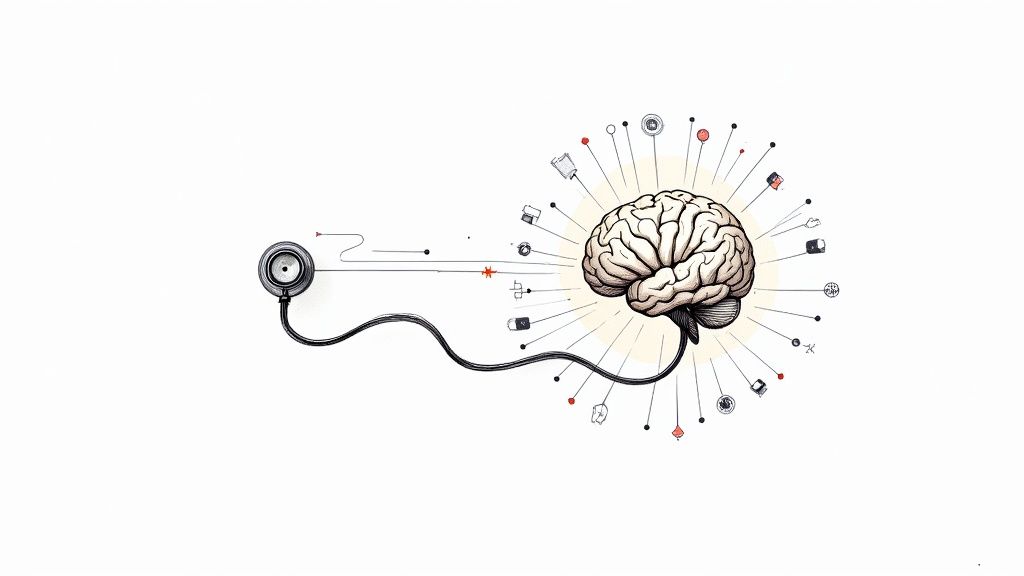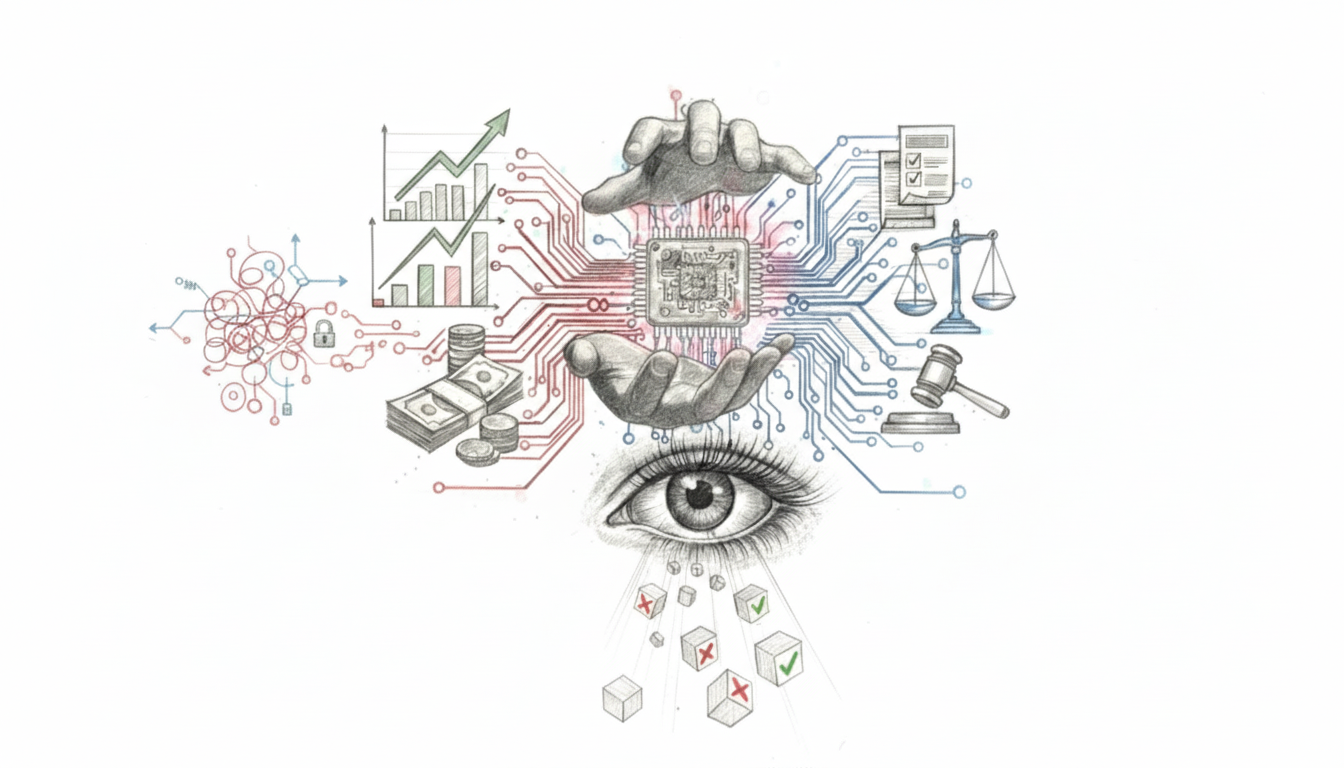Explore Innovative Co-Creation Models to Boost Innovation
Learn about effective co-creation models to drive product success. Discover real-world strategies and start collaborating better with your customers.
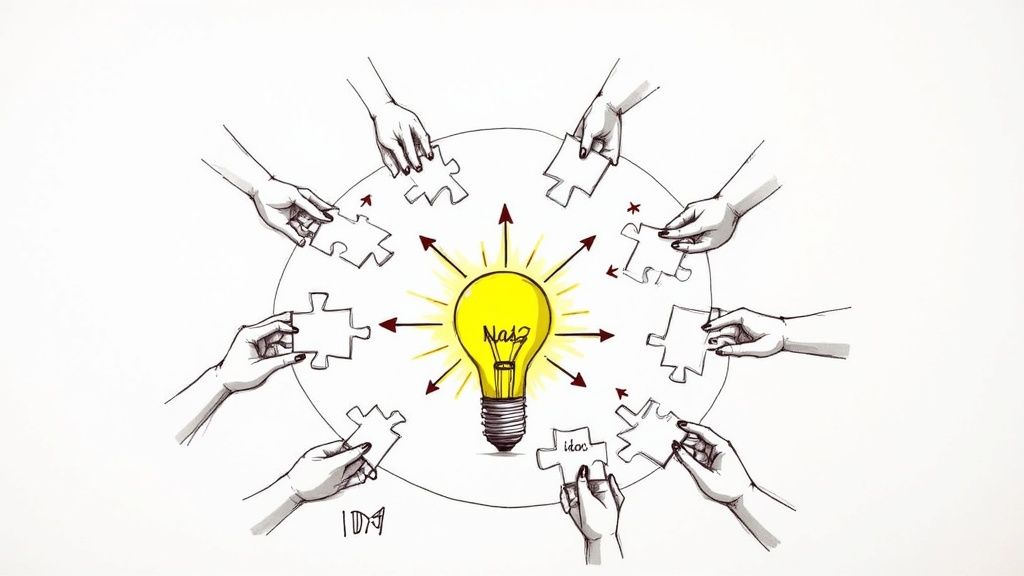
Let's be honest, building products in a vacuum just doesn't work anymore. The old way of doing things often felt like a monologue, where a company would develop an idea in isolation and then simply push it out to the market. Co-creation completely flips that script. It’s about starting a dynamic dialogue, building with your customers, partners, and community to create something genuinely innovative.
Why Co-Creation Is Your New Innovation Engine
In today's crowded market, the products that truly succeed are the ones that solve real-world problems and connect with people on a deeper level. This is exactly why co-creation has become so essential for modern businesses. It represents a massive shift in perspective, moving away from a company-centric model to a customer-centric one. Your end-user is no longer just a passive consumer; they become an active partner in the creative process.
This collaborative method is about far more than just gathering feedback. It’s about tapping into the collective intelligence of your entire ecosystem. When you directly involve your users, you gain unfiltered access to their firsthand experiences, unspoken needs, and brilliant ideas that your internal teams might never have considered. Think of it as a direct line to your market, one that dramatically cuts down the risk and cost of building something nobody actually wants.
The Power of Collective Intelligence
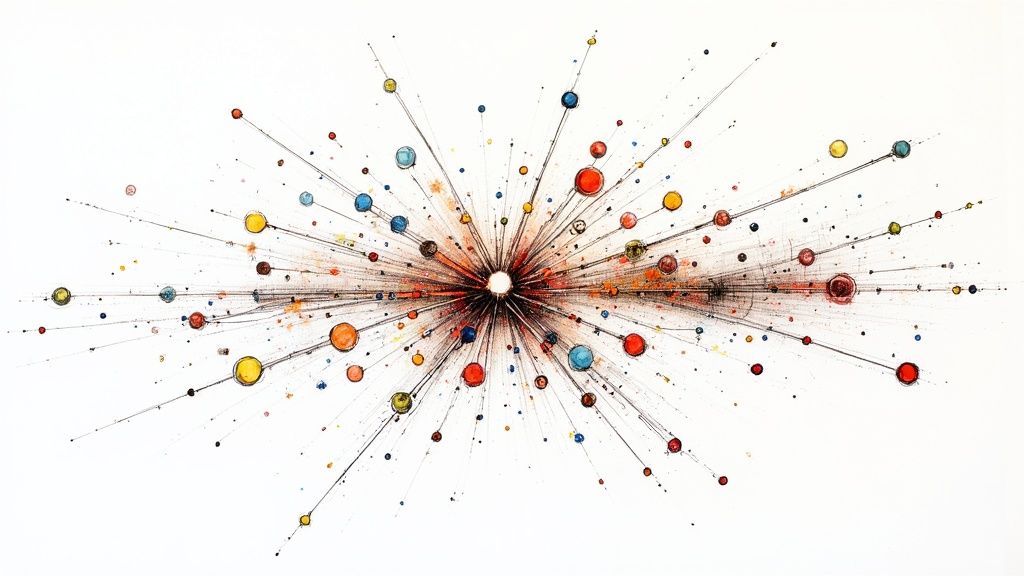 When you open your doors to co-creation, you invite in a rich and diverse pool of knowledge that simply doesn't exist within your organisation's four walls. This isn't just about what customers say they want; it’s about digging deeper to understand the motivations and frustrations that drive their behaviour.
When you open your doors to co-creation, you invite in a rich and diverse pool of knowledge that simply doesn't exist within your organisation's four walls. This isn't just about what customers say they want; it’s about digging deeper to understand the motivations and frustrations that drive their behaviour.
This process becomes even more powerful when you use tools like AI co creation to analyse huge amounts of user input almost instantly. In fact, a solid AI strategy consulting plan will almost always have co-creation as a cornerstone, ensuring that any new solution is firmly grounded in real-world needs.
Academic research even breaks down the knowledge you gain from users into two types: tacit (the unspoken stuff) and explicit (the clearly stated). This includes knowing what your users need, how they go about their day, why they run into certain roadblocks, and who influences their choices. Forward-thinking German companies have been mastering this for years, using methods like social media analytics and netnography to capture these subtle insights. By deeply involving customers in the development cycle, they've significantly improved their innovation success rates.
From Monologue to Dialogue
Let's take a quick look at how co-creation truly changes the game compared to the old way of innovating.
Comparing Traditional vs. Co-Creation Innovation
Aspect
Traditional Model
Co-Creation Model
Source of Ideas
Internal teams (R&D, marketing)
Internal teams, customers, partners, community
Customer Role
Passive recipient, end-user
Active participant, co-creator, partner
Process Flow
Linear, sequential (idea -> build -> launch)
Iterative, cyclical (continuous dialogue & feedback)
Risk Factor
High (based on assumptions)
Low (validated by real users)
Outcome
A product the company thinks users want
A solution users know they need
As you can see, the difference is stark. It’s a move from a closed, top-down process to an open, collaborative one.
The traditional model is rigid and insular. An idea is born inside the company, gets built, and then gets launched with fingers crossed. This so often results in a massive disconnect between the final product and what people actually need. Co-creation, on the other hand, transforms this into a continuous, interactive conversation.
By involving customers early and often, you're not just validating ideas—you're building a community of advocates who are personally invested in your product's success. This sense of ownership creates unshakeable loyalty that marketing budgets alone can't buy.
This collaborative spirit creates a culture of openness and shared purpose. It steers your team away from making decisions based on assumptions and towards making them based on evidence, guided by the very people you're trying to help. Ultimately, co-creation isn't just a one-off tactic; it's a vital part of any modern AI strategy framework aimed at driving sustainable growth and staying relevant in the market.
Choosing Your Co-Creation Model
Picking the right way to co-create is a bit like choosing the right tool for a job. You wouldn't use a sledgehammer to hang a picture frame, would you? Similarly, different business goals call for different co-creation models. The key is to figure out if you need broad, sweeping ideas or targeted, expert feedback, and whether your company or your customers should be in the driver's seat.
Getting this choice right is the first step towards building an effective AI strategy framework that genuinely taps into the power of working together. So, let’s walk through the four main models to help you find the perfect fit for what you want to achieve.
The payoff for choosing wisely can be massive. The infographic below shows just how much of a difference co-creation can make to the bottom line.
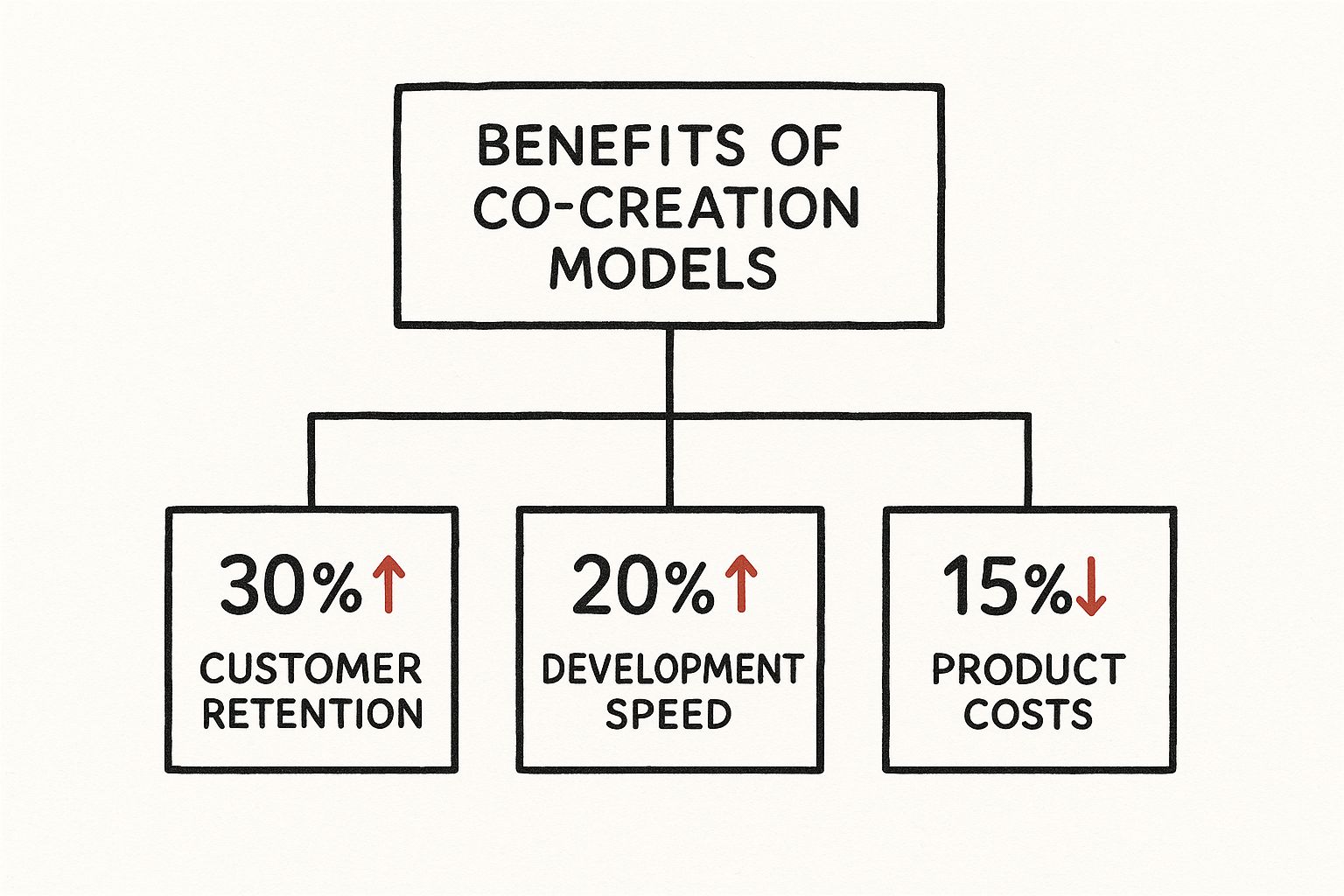
As you can see, the numbers speak for themselves. We're talking about real, tangible benefits like a 30% increase in customer retention, getting products to market 20% faster, and even a 15% reduction in product costs.
The Four Core Co-Creation Models
These models are usually mapped out on two simple axes: who is leading the charge (the company or the customer?) and who gets to join in (is it open to everyone or a select few?). This gives us four distinct quadrants, each with its own unique flavour and purpose.
1. The Club Model (Exclusive & Company-Led)
This is your "inner circle" approach. Here, the company hand-picks a small, exclusive group of customers, partners, or experts—often called a Customer Advisory Board or CAB—to provide deep, ongoing feedback. They become your trusted advisors.
- Best For: Getting detailed feedback on complex products, validating your strategic roadmap, or working closely with high-value clients.
- Real-World Example: When Slack was planning a major redesign, they didn’t just guess what users wanted. They created a pilot group of 100 users who gave feedback in real-time within a shared channel, allowing the design team to iterate and refine things on the fly.
2. The Crowdsourcing Model (Open & Company-Led)
Think of this as casting a very wide net. You set the challenge or ask the question, but you invite a large, undefined group of people to contribute ideas. The company is still steering the ship, but the door is wide open for anyone to hop on board.
- Best For: Brainstorming new ideas, spotting untapped market opportunities, or solving a specific problem by tapping into a wide range of perspectives.
- Real-World Example: LEGO Ideas is the classic example. The platform lets anyone submit a design for a new LEGO set. If an idea gets 10,000 votes from the community, it goes into an official review. Many of these fan-made designs have become best-selling commercial products.
This open approach to innovation ensures that companies aren't just listening to the loudest voices, but are tapping into the collective creativity of their entire user base. It turns product development into a democratic process.
Shifting Leadership to the Customer
The first two models keep the company firmly in control. But what happens when you hand the reins over to your customers? The next two models do just that, and the results can be incredibly authentic and community-driven. An AI Strategy consulting tool can be a great help in managing all the input from these more user-led projects.
3. The Community Model (Exclusive & Customer-Led)
In this model, an exclusive group of your most passionate fans takes the lead. They build a community around your brand or product and drive the innovation themselves, with the company often acting more as a facilitator than a director. It's all built on shared interests and genuine expertise.
- Best For: Fostering fierce brand loyalty, creating a powerful user support network, and encouraging deep engagement among your core advocates.
- Real-World Example: Asana does a brilliant job with its "Ambassadors" and "Voice of Customer" programmes. These super-users work together to identify pain points and co-develop solutions, creating a powerful feedback loop that directly shapes the product’s future.
4. The Open-Source Model (Open & Customer-Led)
This is the most decentralised and open model of them all. Innovation is completely driven by the community and is accessible to everyone. The product—often software code—is publicly available, and anyone can contribute, modify, or improve it. The company's role is often minimal, maybe just providing some infrastructure or light stewardship.
- Best For: Developing software incredibly quickly, enabling collaboration on a massive scale, and creating new industry standards.
- Real-World Example: The Linux operating system is the ultimate poster child for this model. It was built, and is still improved daily, by a global community of developers. There’s no single company telling it what to do; it evolves organically based on what its users need and contribute.
Nailing down the right model is a fundamental first step. Whether you need the focused guidance of a select club or the wild creativity of a crowd, matching your approach to your goals will set you up for success from the very beginning.
The Business Case for Co-Creation
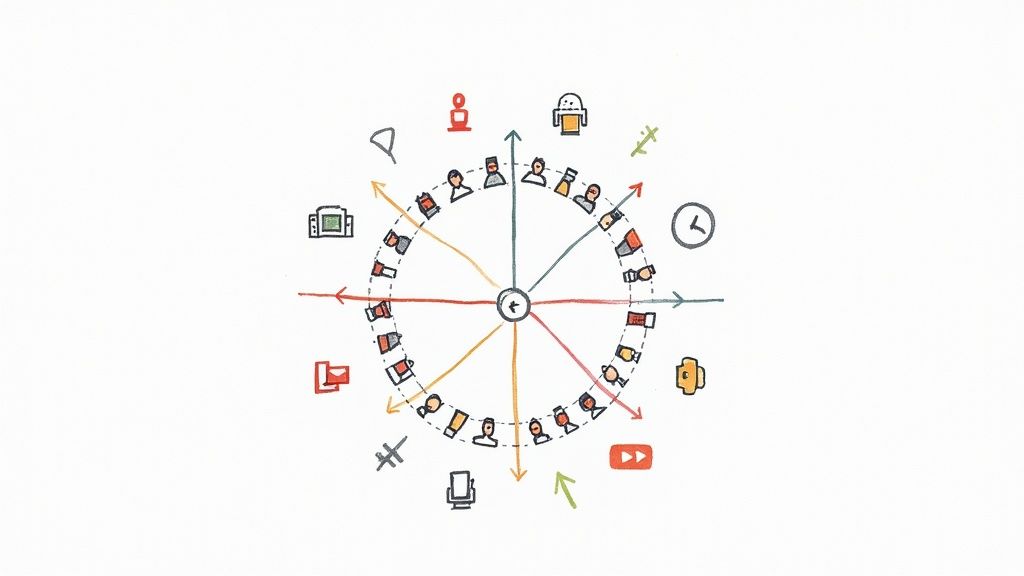
Picking the right co-creation model is one thing, but understanding the real, tangible results it can deliver is what gets everyone on board. Let’s move past the theory. Co-creation isn’t just a nice-to-have; it delivers powerful, measurable benefits that directly strengthen your bottom line and sharpen your competitive edge. It’s a strategic move for any organisation that’s serious about growth.
When you bring users directly into the development process, you dramatically cut the risk of a commercial flop. Think about it: instead of spending a huge budget building a product based on what you think people want, you're creating a solution with a built-in market fit from day one. This kind of proactive validation is a key part of any smart strategy because it aligns what you build with what people actually need.
Accelerate Innovation and Reduce Risk
One of the most powerful arguments for co-creation is how it changes your relationship with speed and risk. Traditional R&D can be a slow, expensive grind, full of uncertainty. The last thing you want is to hear the word “pivot” after sinking hundreds of thousands of pounds into a project.
Co-creation is your de-risking engine. By involving customers early and often, you spot potential problems and fix them long before they become expensive mistakes. This continuous feedback loop gives you some serious advantages:
- Faster Time-to-Market: When you’re validating ideas with real users as you go, you spend far less time on rework and course corrections.
- Reduced Development Costs: Building the right features the first time around means you stop wasting money on functionality nobody asked for.
- Built-in Market Validation: A product co-created with your target audience already has a group of people who understand it, value it, and are ready to use it.
This process ensures your investments are guided by genuine market demand, not just internal guesswork.
Build Unshakeable Customer Loyalty
What happens when a customer sees their own idea come to life in your product? They don't just stay a user; they become a true advocate. Co-creation is one of the most effective ways to build deep, meaningful relationships with the people you serve.
When customers feel heard and see their contributions make a real difference, they develop a sense of ownership. They become personally invested in your brand’s success. This emotional connection creates a level of loyalty that marketing campaigns alone simply can't buy.
It’s a two-way street that builds mutual respect, turning a simple transaction into a genuine partnership. Companies that get this right find their customers become their most passionate supporters. Look at Zoom—its explosive 326% growth in 2021 was fuelled by a customer-centric approach that turned even free users into evangelists.
Foster a Culture of Open Collaboration
Beyond the product itself, co-creation has a massive impact on your internal culture. When you embrace this approach, you send a clear signal that you’re moving away from closed-off, siloed thinking. You’re building an environment of openness, curiosity, and shared purpose.
It pushes your teams to listen more and assume less, teaching them to value outside perspectives as a vital source of new ideas. This cultural shift is priceless. It creates a more agile, responsive organisation that’s far better equipped to handle whatever the market throws at it. When your entire company starts thinking with the customer, you unlock a powerful engine for long-term growth.
Putting Co-Creation Into Action
So, you're sold on the idea of co-creation. That’s the easy part. The real challenge is moving it from a concept on a slide deck to a living, breathing programme that actually delivers results. How do you make it happen?
It’s about building a bridge from theory to practice. This isn't just about throwing open the doors and asking for ideas; it requires a thoughtful, structured approach. Let's walk through the essential stages to get your own co-creation initiative off the ground and ensure it creates genuine value.
Stage 1: Define Your Core Objectives
Before you send a single email or post an invitation, stop and ask the most important question: What are we trying to achieve here? Without a clear answer, you’re just collecting noise.
Vague goals like "get customer feedback" will lead you nowhere. You need to be specific. Are you trying to iron out the bugs in a specific feature? Are you fishing for a brand-new product idea? Or maybe you're looking to overhaul your entire customer onboarding process?
Pinpoint exactly what success looks like. This clarity becomes your North Star, guiding every decision you make from here on out.
Your objectives could be things like:
- Slash user-reported issues for our checkout process by 30% in the next quarter.
- Generate 10 feasible new product concepts from our power users within 60 days.
- Improve the adoption rate of our new mobile app by 15%.
Getting this right from the start is what separates a focused, impactful programme from a chaotic waste of time.
Stage 2: Find and Engage the Right Participants
Your co-creation programme is only as good as the people in it. This isn't a numbers game; it’s about finding the right people. You need contributors who not only want to help but also have the specific insights you need to hit your objectives.
Think carefully about who holds the knowledge you’re seeking. If you’re refining a complex piece of software, your power users—the ones who know every shortcut and workaround—are your goldmine. But if you’re exploring an entirely new market, you’ll want a much broader mix of people to get fresh perspectives. Don't be afraid to segment your audience and craft an invitation that speaks directly to them, showing them why their unique viewpoint matters.
The key to sustained engagement is making your participants feel valued. This isn't a one-way street where you just extract ideas. It's a collaborative partnership built on mutual respect and a shared desire to create something better.
Keeping that initial excitement alive is crucial. You need to communicate regularly, be transparent about how their feedback is being used, and publicly celebrate their contributions. This is what keeps people invested for the long haul.
Stage 3: Choose Your Tools and Frameworks
With your goals set and your dream team assembled, you need the right setup to make the magic happen. The technology and frameworks you choose should make it incredibly simple for people to share ideas and for your team to manage all that valuable input.
The right tools can turn a messy flood of feedback into a well-organised innovation pipeline. As we explored in our AI adoption guide, using an AI-powered tool to analyse requirements can help you systematically capture and structure what everyone is saying, ensuring no perspective gets lost. Similarly, a hands-on design thinking workshop provides a fantastic, interactive setting for deep collaboration. Choosing the right format for an innovation workshop is absolutely critical for sparking genuine, productive teamwork.
Stage 4: Integrate and Implement the Results
This final stage is where the rubber truly meets the road. All the fantastic ideas and brilliant feedback you've gathered are worthless if they just sit on a digital whiteboard. You must have a clear process for evaluating, prioritising, and—most importantly—acting on what you've learned.
This means closing the loop. Go back to your participants and show them what you’ve built because of their input. This is an incredibly powerful moment. It proves you were listening, validates their effort, builds trust, and makes them eager to help again. When you nail this part, you turn a one-off project into a continuous cycle of improvement, fuelled by the collective intelligence of your community.
Learning From Real-World Co-Creation Wins

Theories and frameworks are useful, but the real magic happens when you see them in action. It's one thing to talk about co-creation, but it’s another thing entirely to see how real businesses have used these ideas to solve tricky problems and get incredible results.
These stories, from world-famous brands to specialised German innovators, show how powerful it can be to innovate with your customers, not just for them. By looking at their challenges, the models they chose, and what they achieved, we can see co-creation for what it is: a repeatable strategy for genuine growth.
Lego Ideas: Turning Fans Into Designers
Lego Ideas is probably one of the most famous examples of the Crowdsourcing model done right. The company faced a constant challenge: how do you keep coming up with fresh ideas that capture the imagination of such a devoted, diverse fanbase? Their answer was beautifully simple: let the fans design the next Lego set.
The platform invites anyone to submit a product idea. If that idea gathers 10,000 votes from the community, it lands on the desk of Lego’s own designers for an official review. This process has given us some of Lego's most popular sets, like the "Women of NASA" collection and stunningly accurate replicas from beloved films.
The real brilliance here is that Lego validates market demand before a single brick gets made. They aren't just getting free R&D; they're getting fully-formed concepts with a passionate audience already lined up to buy them.
Structuring High-Tech Innovation in Germany
In Germany, co-creation is being used in a more structured way to push technological boundaries. A fantastic example is the Fraunhofer AHEAD programme, which started in 2019. It’s essentially a co-creation hub that brings together Fraunhofer researchers, startups, and large companies to work on projects tied to the UN Sustainable Development Goals.
The programme manages about 80 high-tech projects every year, using a digital system to match the right partners from across 74 Fraunhofer institutes. It's a testament to how a formal, organised co-creation approach can get very different groups to collaborate and create something truly meaningful.
Asana and the Power of Community
Project management tool Asana is a great case study for the Community model. They’ve built incredibly strong ties with their most active users through programmes like their Ambassadors and Voice of Customer initiatives.
Asana brings together these "super-users" and gives them a real say in the product's direction. These community leaders collaborate to pinpoint problems, brainstorm solutions, and offer feedback that shapes the tool's evolution.
This approach hits two birds with one stone:
- It creates an invaluable feedback loop, making sure the product roadmap stays grounded in what users actually need.
- It builds incredible brand loyalty. These users don't just feel heard; they feel like genuine partners in the company's journey.
These examples are just the tip of the iceberg. If you're looking for more ideas, feel free to browse our full library of real-world use cases and see how these strategies are being applied in different sectors. And when you're ready to write your own success story, our expert team is here to help you find and launch the perfect co-creation model for your goals.
Navigating the Challenges of Co-Creation
While co-creation sounds fantastic in theory, the reality is that it’s rarely a smooth ride. Bringing people together to innovate is powerful, but it also means juggling different personalities, clashing opinions, and a whole lot of moving parts. Getting ahead of these hurdles is what separates a co-creation programme that fizzles out from one that truly succeeds.
Think of it this way: you wouldn't launch a major tech initiative without a solid AI strategy framework, right? The same logic applies here. A clear plan for your co-creation efforts helps you spot potential roadblocks early and have solutions ready before they can grind everything to a halt.
Managing Expectations and Sustaining Motivation
One of the first traps you can fall into is mismanaging expectations. When you invite customers to contribute, they're not just giving you feedback; they're investing their time and passion. If their ideas vanish into a corporate black hole, that initial excitement will quickly turn into disappointment.
Keeping that fire alive over the long haul is just as tough. The novelty wears off, life gets in the way, and participation can drop. To keep people engaged, you need to be proactive.
- Be Radically Transparent: Keep everyone in the loop on what’s happening, even when progress is slow. Show them how their input is being used.
- Celebrate the Small Victories: Acknowledge great ideas and valuable contributions as they happen. It’s a simple way to show people their effort is genuinely valued.
- Always Close the Loop: When a product feature they helped shape finally goes live, make sure they’re the first to hear about it. Nothing builds loyalty like seeing your ideas come to life.
Navigating Intellectual Property and Scope Creep
Two major operational headaches are intellectual property (IP) and scope creep. When an outsider contributes a brilliant idea, who actually owns it? This can get messy fast. It is absolutely crucial to have clear IP agreements sorted out right at the start to prevent legal battles and bad blood later on.
Then there's scope creep—the slow, creeping expansion of a project beyond its original goals. It's so easy to get distracted by shiny new ideas that pop up along the way. Without strong governance to keep everyone focused, your project can quickly become a bloated, unmanageable mess. An AI Strategy consulting tool can be a lifesaver here, helping you structure all the inputs and keep the project on track.
The EU Horizon 2020 project SCALINGS took a deep dive into co-creation in Germany and uncovered some systemic challenges, particularly around fair power distribution and social inclusion. Their research showed that to really unlock co-creation's potential, you have to get these foundational elements right. Discover more insights from the SCALINGS project.
Ensuring Fairness and Inclusion
The SCALINGS research highlights a much deeper challenge: making sure the entire process is genuinely fair and inclusive. It’s all too common for the loudest or most confident people to dominate the conversation, drowning out equally brilliant ideas from quieter contributors.
To foster a truly collaborative spirit, you have to consciously work to give everyone a voice and a real stake in the outcome. This isn't just about being nice; it leads to stronger, more innovative ideas and helps build a fiercely loyal community around your brand. Tackling these challenges head-on is what turns co-creation from a simple business tactic into a sustainable engine for growth.
So, what’s the big picture here? If there’s one thing to take away, it’s that co-creation isn't just another business trend; it’s a genuine shift in how great companies operate and grow. It’s about moving on from the old model of creating for customers and embracing a new one where you create with them. This approach turns your customers, partners, and community into genuine collaborators in your success story.
We've walked through the different models, explored the real-world benefits, and laid out the steps to get a programme off the ground. Now, it's your turn to put it into action.
The journey doesn't start with a massive, company-wide overhaul. It begins with one small, intentional step. Pick a manageable project to start with. Experiment with a single co-creation model that aligns with your immediate goals. Think of it as building your company's collaborative muscle—you start with lighter weights and build strength over time.
The most successful companies view co-creation not as a one-off project, but as a continuous dialogue. It's about creating a sustainable cycle of feedback, implementation, and shared success that builds momentum and deepens relationships with every iteration.
Your Next Step in Collaborative Growth
This whole process is about much more than simply collecting ideas. It’s about fostering a deep-seated culture of partnership. By starting small, you give yourself the room to learn what truly works for your organisation, fine-tune your approach, and then scale your efforts when you're ready. The most crucial part is simply to begin.
As you move forward, keep in mind that the most powerful breakthroughs happen when you blend your team's internal expertise with fresh, external perspectives. We’ve covered everything from the strategic value of an AI strategy framework to the critical insights you can uncover through a detailed AI requirements analysis. Each piece of the puzzle helps build a stronger, more customer-focused innovation engine.
If you’re ready to stop guessing what your audience wants and start building the future alongside them, we're here to help you design and launch a co-creation strategy that delivers real, measurable results.
At Ekipa AI, we transform collaborative ideas into scalable impact. If you're ready to design a co-creation strategy for your business, our expert team is here to help you build the future, together.

